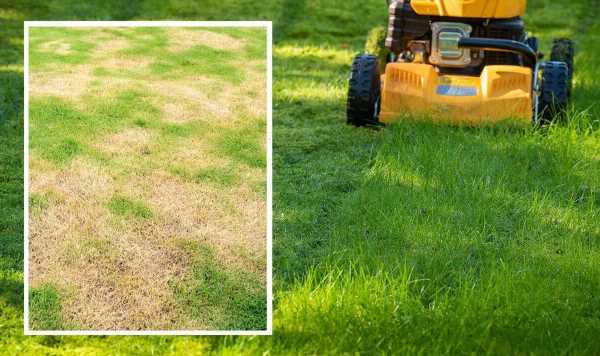
Lawn care: ‘Instantly’ repair brown patches and get grass ‘growing aggressively’
05/20/2022Home Depot: How to ready your lawn for Spring
We use your sign-up to provide content in ways you’ve consented to and to improve our understanding of you. This may include adverts from us and 3rd parties based on our understanding. You can unsubscribe at any time. More info
With summer just around the corner, gardens up and down the country will be starting to bloom. But there’s nothing worse than having an abundance of colour from flowers and plants, only for them to be offset by unsightly grass. Express.co.uk spoke to Jonathan Hill, Sales Director at Rolawn about how to take care of your lawn, including any brown patches, and return it to its lush, thick, green potential.
Jonathan explained what brown patches on the lawn mean and whether they are diseases or just dead grass.
He said: “Brown patches in your lawn are unsightly and can appear overnight.
“The discoloured patches can be caused by various things, the most common being either a form of fungal turf disease or insects in and under the lawn.
“Other causes may be animal urine, compaction, a spill of a fluid (petrol, oil) or even a spill of lawn fertiliser.
“The fungal diseases that impact turf usually start with a palm sized area, around 75mm and can spread up to 600mm in diameter.
“They are usually associated with damp conditions, therefore, often visible after wet weather and more common when weather is still for a prolonged period, accompanied by seasonal high or low temperatures.
“They are usually a foliar disease, being associated with the leaf and are unlikely to actually kill off the grass plants.
“To determine if the brown patch is being caused by insects simply use a fork or spade to inspect under the patch to find any evidence of grubs, maggots, flies, or beetles. One or two will not be the issue, this is normal, however, if you find a dense patch then this is the likely cause of the issue,” he commented.

For any gardener looking to fix the brown patches on their grass, Jonathan shared a few steps.
Treating a disease
Jonathan said: If treating a brown patch caused by a fungal foliar disease, the good news is that being a foliar disease usually only the leaves are damaged.
“Having been caused by nature impacting growing conditions, nature will provide the answer as a change in the weather will prevent the disease from spreading.
“Healthy turf will recover relatively quickly, however, if need be some seed and sifted topsoil can be used to make up a patch repair.
“There are fungicides available, however, these should be used as a last resort.”
Damage from insects
“If insects are suspected to be the cause identification will help with understanding how to deal with the species concerned,” the lawn expert added.
“But, with the exception of ants, most other insects that cause brown patches will hatch into the adult form and then fly off.
“Commonly seen with crane fly and fit fly. This is normal and in many instances going on without us ever noticing.
“After the insects have left the lawn then patch repairs can be made, with either piece of turf or re-seeding.”
Animal urine
“This is best dealt with by a quick response and soaking the area of grass with plenty of fresh water as soon as possible, to dilute the urine and help prevent serious damage,” Jonathan said.
In terms of how long it takes for brown patches to recover, Jonathan continued: “Regardless of the cause, a good lawn maintenance regime will help address issues such as compaction and reduce the impact of pest and diseases.
“Healthy grass plants are more robust, enabling them to cope with more wear and tear, suffer less from foliar fungus and subsequently be quicker to recover from any damage.
“[So] the healthier the lawn in the first place, the quicker it will recover.
“In May when turf should be growing aggressively [and] recovery should be possible within weeks. If using seed to patch repairs this can take a good six weeks, a turf repair is virtually instant.”
Jonathan also revealed the best way to prevent brown patches from reappearing in the lawn again is “with a healthy maintenance regime”.
“Regular mowing, appropriate feeding and ensuring light and air can get to the surface of the lawn.”

Mowing:
“Taller grass stays wetter for longer, which can encourage diseases to develop,” the Rolawn expert said.
“Mowing irregularly stresses the grass plants making them more vulnerable to damage from pests and diseases.
“A little and often in spring and autumn.”
Fertilising (feeding):
“Under and over fertilising a lawn can both encourage fungi in a lawn,” Jonathan said. “A balanced regular feed is just enough to support good growth.
“You can use a lawn establishment fertiliser which feeds turf and grass seed from the roots up. This can be used on a new or existing lawn. With any lawn fertiliser, a ‘slow release’ formula is best.”
Light and air:
“Like humans and most plants, lawns need light and air,” the expert continued. “They both encourage healthy growth allowing the grass plants to breathe and dry out in wet conditions.
“Fungi feed off damp conditions, and insects like soft ground conditions, both of which can lead to brown patches.
“A lawn that does not drain well will stay wetter for longer and again cause your turf to be stressed, grow poorly and be more vulnerable to attack.”
Rolawn’s basic dos and don’ts for lawn care in May:
- Clear lawn debris regularly.
- Move garden furniture and play equipment like trampolines regularly.
- Check mowing blade sharpness and either sharpen or replace blunt blades.
- When cutting your lawn in May a ‘little and often’ approach is best – never remove more than one third of the grass height at a time.
- Feed the lawn in spring and autumn, if you haven’t done so yet this year then now is ideal. Lawns need the right nutrients, in the right quantities. Products such as Rolawn Grow Right lawn fertiliser, for example, will result in a thicker, greener, and denser lawn in the long run.
- Keep your garden lawn weed free. In May they are growing vigorously so cut the weeds out with a knife or a mechanical weeder. Doing this now prevents their seed from spreading, helping prevent further problems.
- In mature lawns, address moss and thatch by scarification. You can do this with a spring-time rake or a mechanical scarifier.
- If your lawn is compacted, it may require aerating in May to help relive compaction and improve drainage. Use a garden fork or hire an aerating machine.
- If your lawn is uneven, top dressing in early May will help even out low areas, break down thatch and improve drainage. Using Rolawn Top Dressing on a dry lawn up to three litres/square meter will be sufficient
- You may need to overseed the lawn during May. By mixing a product, such as Rolawn’s Medallion Premium Lawn Seed, with Lawn Top Dressing, brush into the lawn surface for a better quality of lawn.
About Rolawn:
Rolawn is the UK’s leading turf grower and supplier. Rolawn supplies premium turf, high-quality topsoil, barks, and lawn care products.
Established in 1975, it thrives on innovation.
Chairman and Managing Director, Paul Dawson, continues to drive the family business ethos, putting research and development at the heart of Rolawn’s service, providing customers with ever-improving products.
Source: Read Full Article

